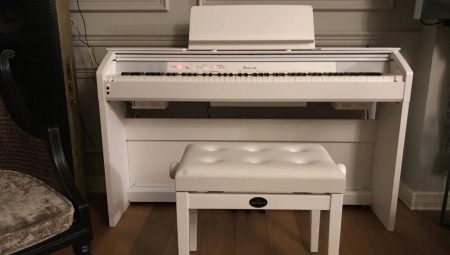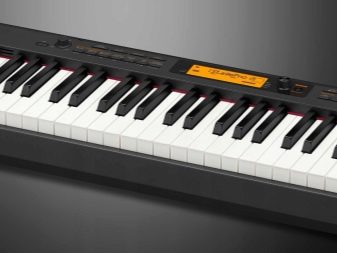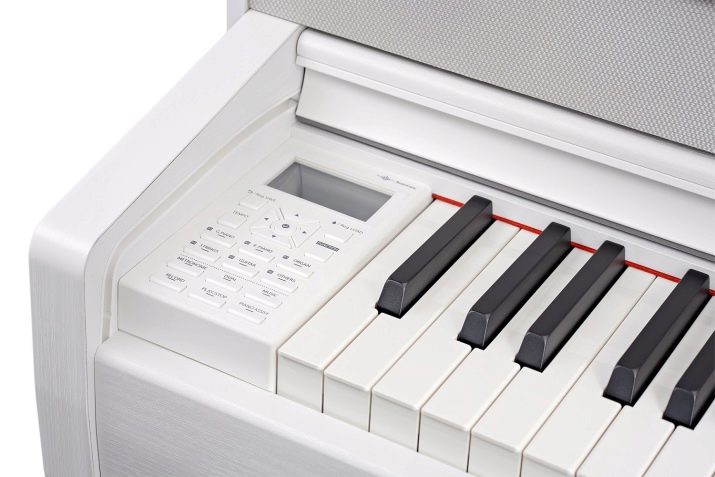All about the electric piano

For a long time, it was believed that learning the performing arts was truly possible only on the acoustic piano. A feature of the instrument was the dependence of the strength and nature of the sound on pressing the key, which was not available on synthesizers. However, the development of electronic music has led to the emergence of analogs of the piano, capable of imitating the ratio of tactile sensations and sound. The features, advantages and rules for choosing an electronic piano are worth considering in more detail.


What it is?
An electric piano is a keyboard instrument whose sound comes from samples rather than hitting a string with a hammer.

Sample Is the recorded sound played on an acoustic instrument. Well-tuned concert grand pianos are used for this recording. Then the specialists alternately record the sound of each key with different pressing force, open and closed lids, with the pedal pressed. The resulting records are embedded in the instrument.

The more samples are used in the piano, the cleaner and more natural it sounds, and the more complex compositions you can play on it.

The result is an instrument that is not only not inferior in capabilities to an acoustic analog, but also surpasses it in quality.
- An instrument familiar to a musician needs regular tuning. Failures in tuning can be the result of temperature changes (for example, when the central heating is turned on or off), regular use or mechanical damage to the instrument. The electric piano lacks this weakness.
- The volume of an acoustic instrument is almost impossible to control. As a result, the ability to practice the game has a time limit.Electronic piano speakers adjust the sound level. This makes it possible to study without annoying the neighbors.
- When buying an acoustic piano, the first question is choosing where to install it. The electronic version is more compact in size, which partially eliminates this problem. And the light weight will create less inconvenience during transportation.
- The user gets at the disposal of additional features, including a metronome, a set of timbres, the ability to simulate playing in an ensemble, apply special effects, create arrangements and record your own compositions without a specially equipped studio. Features described are not available for all models.
- Another advantage of the electric tool is the use of a more varied range of colors. Therefore, it is not difficult to choose an option that is in harmony with the interior.

The disadvantage of this option is the lack of samples, which does not give a sufficiently rich sound coloration. In addition, it is difficult for a student who is studying an electronic instrument at home to adjust to playing a regular piano in class. However, these disadvantages are inherent in the cheapest models. When you buy a quality digital piano, its acoustic properties are as good as the original.


Description of species
Depending on the size, the tools are divided into the following types.
- Compact or stage. They are distinguished by the absence of a wooden stand. This option is convenient for musicians who are forced to transport an instrument or, due to rare use, keep it in a closet.

- Case... This option remains compact but features a lightweight wood chipboard cabinet, a cover that covers the keyboard, and a console with three pedals. This addition allows you to deliver better speakers.

- Classic case. It uses a massive cabinet with speakers that convey more piano tones.

The last 2 options have better acoustics, but are not designed for frequent transportation.
Top brands
Popular among digital piano manufacturers Casio... This brand has been considered the leading brand in the power tool industry for many years. The developments of Japanese engineers working for the company have made learning and playing the piano more accessible and convenient. The lineup includes the simplest models (CDP-S100), variants of the middle category with additional features, as well as tools with advanced functionality. So, The CDP-S350 combines the capabilities of an electric piano and synthesizer.


Merits the products of this brand are considered to be compact in size, the convenience of the keyboard. The developed series of hammer-type CDP-S attracts with full weight, elasticity and quick return of the keys. In expensive models, the capabilities of the tool can be controlled through a special mobile application. Sometimes this is a good help in learning new songs.
Casio's main rival in this area is another Japanese manufacturer - Yamaha... The brand's lineup includes compact options with a minimum set of functions and costing about 30,000 rubles (Yamaha NP-32WH, Yamaha P-45). The company also produces premium instruments with a wide range of capabilities (Yamaha CLP-645WA, Yamaha P-515). The price for them starts from 130-150 thousand rubles. There are options with the middle price segment (50-90 thousand rubles).


Benefits of Yamaha Products consider the production of instruments for musicians with different needs and levels of training, a wide range of models, the ability to buy a budget piano with the introduction of the latest functions. Such products differ from competitors' offers by the quality of the keyboard, the realistic sound, the clarity of timbres and the breadth of the dynamic range.
In addition to these digital music giants, consider Roland or Becker.These brands also represent pianos of different price and technical content.


Criterias of choice
Considering that electric pianos differ in functionality and sound, purchasing an instrument should be considered responsibly. During the verification process, experts recommend:
- evaluate the duration and quality of the sound by holding the key until it fades;
- check the reaction of the system to pressing force;
- listen to a demo song to get familiar with the sound quality;
- Alternatively, play something yourself, asking a friend to judge the quality of the performance from the outside.

To simplify the choice of a tool, it is worth getting acquainted with the characteristics of its main components, presented below.
Keyboard
Keys - this is the first thing a musician's hands come into contact with. Depending on the technique of execution, they are of the following types.
- Hammerheads, where the function of the strings is performed by sensors that send signals to the processor. Initially, two-sensor models were created. Their disadvantage was the lack of sound when the key was pressed incompletely. As a result, it quickly became impossible to play single note rehearsals. Therefore, newer and more expensive piano variants have added a third sensor that responds to a short pressure range.
- Graduated keyboard... Its designers calculated the weight of each key based on the characteristics of the acoustic instrument. This helps to recreate the tactile sensations of playing the piano in different registers. The only disadvantage of this option is the high cost.


An important parameter when choosing is the material of manufacture. For budget models, plastic is used, sometimes with a synthetic ivory finish.
In the more expensive options, the keys are made of wood imitation, which is more consistent with the texture of an acoustic instrument. However, they do not require maintenance.

Another criterion for choosing a keyboard is the pressure sensitivity. Most of the models on the market have 3 levels. Depending on the setting, the sensors will respond to the pianist's movements a little earlier or later.

Polyphony
In the music world, this word is called polyphony... In the field of electronic instruments, the term is defined as the number of sound waves that a processor will produce at the same time. The modern market offers instruments with polyphony parameters 32, 64, 128, 192, 256.
It should be borne in mind that from the point of view of the program, one sound is not equal to pressing a key. The number of waves is influenced by the strength and speed of the performance, the combination of timbres, and the use of the pedal. If the number of voices exceeds the capabilities of the processor, some of them simply will not sound.

Therefore, for a beginner musician, 48 voices will be enough. A confident performer can consider a model with a polyphony of 128. And an indicator of 256 is suitable for a professional.
Loudspeakers
The quality of this device will determine how loud, bright and rich the instrument will sound. This is important because poor audio output quality can negate the capabilities of a good music processor. Usually the dynamics are assessed:
- by total power;
- location;
- sizes;
- quality.

While technical performance plays an important role in evaluating a device, you shouldn't ignore your feelings. If the quality and strength of the sound coming from the speakers is not aesthetically pleasing, it is better to consider another option.
Appointment
Considering that electronic instruments differ in the set of functions, sound quality and price, you need to choose an option that suits your own needs.
- A professional piano player will choose a model that can master complex performing techniques. An amateur will find an analogue easier and cheaper.
- To perform academic music, it is enough to purchase a version with a comfortable keyboard and high-quality sounding in a piano timbre.
- For concert and pop performance, you should pay attention to the timbres of the organ and wind section, the presence of effects, auto accompaniment and other options.
- It may seem that it is enough for a novice performer to buy the simplest instrument. However, from the first lessons, work begins on the development of ear for music and aesthetics of performance. Therefore, it is not worth saving on the acoustic quality of the instrument.



Game features
Step by step guide.
- The first thing to do is to familiarize yourself with the characteristics of your new instrument. This requirement applies to both beginners and professionals.
- Next, memorize all the keys on the keyboard of the selected piano.
- Play a couple of octaves.
- Watch the movement of your fingers on the keys, memorize the intervals, develop synchrony, while maintaining concentration.
- Play the piano with both hands alternately.
- Learn chords, play them. It will be tough at first, the skill will come with time and practice.
- Try playing a previously listened song. You can play it in parts or in whole at once - whichever is more convenient for you. Try playing as you listen, repeating the song, picking up the notes by ear.
- Experiment with style and tone, don't get hung up on one thing.
- Practice as often as possible: The rehearsal should be at least 25 minutes long and should be done daily.
- Increase your speed gradually.
- Use headphones when playing a digital instrument, especially if your “gigs” are in a city apartment.
- Record your own rehearsals - the electric piano has this feature.
- Find a good teacher if possible.

How to avoid mistakes when choosing an electric piano - in the video below.








